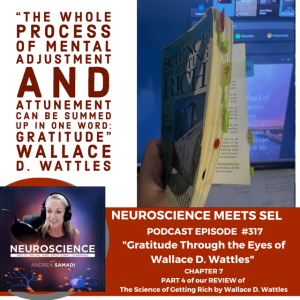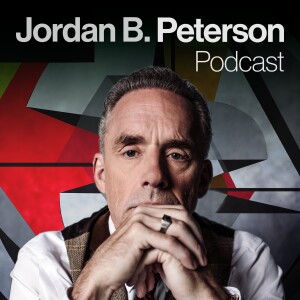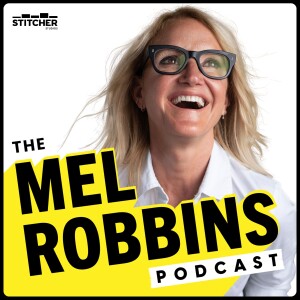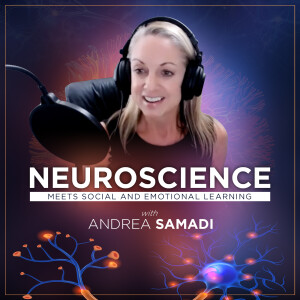
“Gratitude is an attitude that hooks us up to our source of supply. And the more grateful you are, the closer you become to your maker, to the architect of the universe, to the spiritual core of your being.” That’s from Bob Proctor, who writes that Chapter 7 on “Gratitude” from The Science of Getting Rich is “a phenomenal lesson.”
Welcome to our review of chapter 7 of Wallace D. Wattles’ The Science of Getting Rich, published in 1910.
On today's episode #317 and PART 4 of our REVIEW of Wallace D. Wattles The Science of Getting Rich, we will cover:
✔ REVIEW PART 1: Prosperity Thinking vs Poverty Thinking.
✔ Why are our thoughts so important for our results?
✔ Why are Chapters 4/14/7 important chapters for unlocking the "secrets" for wealth and abundance?
✔ Why must we THINK and ACT in a Certain Way to achieve certain results in our life?
✔ Why did Wallace D. Wattles see GRATITUDE as an important component for Wealth and Success in 1910?
✔ 4 STEPS for practicing Gratitude in our Daily Life.
What’s UNIQUE with How to Think and Act in this Certain Way with Gratitude?
What’s new, different and unique about this chapter that unlocks the combination to wealth and abundance within the pages of this book, when we read chapters 4/14 and 7 in this order, for 90 days? It’s within this chapter, on Gratitude, a topic that many of us already know about but I’m going to suggest there’s a much deeper way to look at Gratitude, through the eyes of Wallace D. Wattles. For today’s episode, I hope to tap us into how Wattles thought about Gratitude so we can see, feel and experience this word, gratitude, in a deeper, and more meaningful way.
We covered this topic already on EP 181 on “The Ingredients of an Effective Gratitude Practice” where we connected the most current brain research to this widely used success principle. But what we have NOT covered yet, is how on the earth did Wallace D. Wattles think of this practice as important and then tie it to wealth and abundance in 1910? What did he suggest that we have NOT discussed yet on this podcast? What have we missed, that’s REALLY important? This is the question I ask EVERYONE at the end of an interview. I don’t want to leave any stones unturned.
I’m going to suggest that what we have missed will be revealed when we put these three chapters together, bringing out the “secret within the syllabus of this book” where we learn to THINK AND ACT in this “certain way.” From experience, I can tell you if you follow this activity for 90 days, you will witness strange and marvelous things occur in your world, with constant regularity. You just need to READ and APPLY these 3 chapters, in this order practicing things in this CERTAIN WAY, as Wallace D. Wattles suggests. Then I’m hoping that this review will help you to shorten the time it takes you to experience these AHA moments of learning that took me over 25 years to finally understand and move you quicker towards whatever it is that you want. As I’m writing this episode, I’m STILL uncovering truths that have escaped me previously.
Welcome back to The Neuroscience Meets Social and Emotional Learning Podcast, where we connect the science-based evidence behind social and emotional learning (that’s finally being taught in our schools today) and emotional intelligence training (used in our modern workplaces) for improved well-being, achievement, productivity and results—using what I saw as the missing link (since we weren’t taught this when we were growing up in school), the application of practical neuroscience. I’m Andrea Samadi, an author, and an educator with a passion for learning and launched this podcast 5 years ago with the goal of bringing ALL the leading experts together (in one place) to uncover the most current research that would back up how the brain
This brings us to chapter 7 of Wallace D. Wattles’ The Science of Getting Rich, published in 1910 on “Gratitude.”
When I look in my notebook, the first line I highlighted was line 13 that reads “the whole process of mental adjustment and attunement can be summed up in one word, gratitude.”
Next, I highlighted
There’s a lot more than meets the eye when we read these two important sections of Chapter 7. We could spend the whole episode just talking about this word gratitude, through the eyes of Wallace D. Wattles.
- What does he mean by mental adjustment and attunement?
I will explain this in a way I learned it from all the seminars where this point was hammered home. Let’s say we have a problem that’s weighing us down. It could be a work problem, a relationship problem, a financial problem, or anything that’s on our mind and really messing with us.
We all have been here, and we would have the tendency to want to focus on the problem right? Call up our friends and tell them about it, and say “Hey, what do you think about this?” looking for some sort of comradery from our peers.
Wattles would warn us against this and say that “the moment you permit your mind to dwell with dissatisfaction with things as they are, you begin to lose ground. You fix your mind upon the common, the ordinary, the poor, and the squalid and mean; and your mind takes the form of these things.”
Now reading this passage for 90 days, if you read it out loud, you won’t miss this part. When times are difficult, NEVER talk about them, as this gives them more energy and the problems you are having will grow. Wattles says you must get “involved with this process of mental adjustment” (where you learn to SWITCH your thinking from dwelling on what’s going wrong, to focusing everything you’ve got on what’s going right).
I mentioned this in PART 2[i] of this series that I’m fully aware that Wattles would not want me talking about the difficult times in my past when money was tight, as this would be letting my mind focus on the “common, and the poor” and he warns us against “dwelling on the inferior.” (Chapter 7, Gratitude, SGR). It matters what we think about, and if you think that your thoughts do not affect others, think again. Have you ever heard the idea “before you speak, I’ll hear you?” Our thoughts have a tremendous impact on others, especially those closest to us, so keep them positive and work on strategies to overcome negative thinking when you notice these thoughts creeping in. We dove deep into this on EP 273.[ii]
Over time, if you can develop a habit with this, it will make your life much easier. This is learning the process of “mental adjustment” and making it a habit. Then “attunement” will be to live your life “This Certain Way” where you “attune” yourself to whatever it is that you want. We’ve talked about this concept often on this podcast, where we acknowledge that we are Spiritual Beings, living in a Physical Body, with an Intellect, and everything that exists, is joined together (these levels of vibration) like the colors of the rainbow. Reaching our goals is about “attuning” to the level of vibration or frequency that they sit on.
Wattles mentions these laws starting in Chapter 2 of his book, so he is saying that once we have mentally adjusted our mind (away from what we don’t want, and towards what we do want) that we next need to “attune” ourselves to whatever it is that we want. How do we do this?
With Gratitude
When I ever hear, anyone mention they are grateful for something, it stops me in my tracks. It might sound like a trivial thing to say, but to me, especially after studying this chapter for over 25 years, it’s deeply meaningful.
Dr. Joe Dispenza knows the power of the words “Be grateful for it” as he’s put it in his Courageous Heart Meditation. We know the power of this meditation as he measures his seminar attendees BEFORE and AFTER listening to this, and it has a profound impact on a person’s state of well-being.
Gratitude and Being Grateful for something…is powerful.
Why? Because being grateful connects you directly to your source of supply. The more grateful you are, the closer you become to your maker, to the architect of the universe, to the spiritual core of your being.” (This is the quote we opened up this episode with from Bob Proctor).
Now we are talking. Real Gratitude can be felt, and I don’t know about you, but I’m drawn to those who have a grateful heart. You just want to be near people like this. So how do we become more grateful?
4 STEPS for Putting Gratitude into Practice
When times are difficult, whatever it might be (your health, your work, your relationship, or finances) the minute you find your mind dwelling on the negatives, and catch yourself from feeling sorry for yourself in some way, STOP right there, and practice these 3 steps.
STEP 1: PRACTICE MENTAL ADJUSTMENT
Think about what you are grateful for.
Put the focus on what’s working in your life, instead of what’s going wrong. This might take some time to get your mind past the negatives, but with time, it will become a habit. This is the “mental adjustment” part. I created notepads years ago that I would hand out whoever took my workshops so they could write out what they are grateful for on a list. I first saw this idea used in the seminars.[iii] You can also find Gratitude books, like Jack Canfield’s[iv] so you can create this habit and make it a part of your day. ONCE we’ve practiced, MENTAL ADJUSTMENT:
STEP 2: ATTUNE OURSELVES TO THE SPIRITUAL WORLD: Here is where we implement Gratitude through the eyes of Wallace D. Wattles. We have already mentally adjusted our mind from thinking away from what we do not want, to what we DO want, and created our list of what we are grateful for. This itself (having a grateful heart) hooks us up to our source of supply. We have not ever mentioned God on this podcast (yet) but this is what I could call my maker, or the architect of the universe that Gratitude connects me to. You might call it something else, but it’s here that we acknowledge there’s something bigger than ourselves. Dr. Andrew Huberman recently said on a podcast with Lex Fridman that he has recently started to use prayer in the morning when “there’s something he cannot resolve on his own.” He acknowledges that “prayer is powerful” and “gets you outside of yourself” and that “there’s something bigger than me, bigger than nature, that I can’t understand or control to give over to it.”[v] (talking about his problems).
Wattles explains it this way when he says “First, you believe there is one Intelligent Substance, from which all things proceed; (what is this substance-call it what you will, I call it God) second, you believe this substance gives you everything you desire; and third, you relate yourself to it by a feeling of deep and profound gratitude.”
I don’t ever want to push my beliefs on others, but there are just some things that we cannot explain. I spend my spare time hiking in the mountains in Arizona, and I can’t put into words what I feel at certain parts of the hiking trail. There is a definite connection to the spiritual world, (that I feel) and I don’t know when I started doing this, but I throw out anything I want solved off the edge of the mountain, and wait to see what answers come to me.” Sounds incredibly strange, (to say this out loud, or maybe not if you do something similar) but when I heard that Stanford Professor Dr. Andrew Huberman uses prayer every morning, and then I made the connection that “a grateful heart” connects us to our source of supply, I started to see this practice as more magical than strange. I just cannot explain anything I see, or feel as I’m going outside of myself for answers or solutions, but it all begins with a grateful heart.
I just know that whatever it is that I see and feel, that when I say “thank you” after whatever it is that I’ve asked for, it feels like magic. I hear an imaginary “your welcome” as I know that I’m connected to the world is a way that I’ll never be able to explain with neuroscience.
STEP 3: GUARD OUR THINKING: “Do not permit your mind to dwell on the inferior” (Wattles, Chapter 7, Gratitude) but “surround yourself with the best to become the best.” It matters who you hang out with as the thoughts that you think, the words that you speak, all matter.
STEP 4: EXPECT GOOD THINGS TO HAPPEN
“The grateful mind continually expects good things, and expectation becomes faith. The reaction of gratitude upon one’s own mind produces faith. “It is necessary, then, to cultivate the habit of being grateful for every good thing that comes to you; and give thanks continuously.” (Chapter 7, Wattles, SGR).
REVIEW AND CONCLUSION
To review and conclude PART 4 of our Deep Dive of Wallace D. Wattles’ The Science of Getting Rich, we covered Chapter 7, on Gratitude.
REMEMBER:
PART 1[vi] of our review, we’ve seen the importance of opening up our minds to prosperity thinking, (that there is more than enough for all of us vs poverty consciousness that there is not enough) and PART 2[vii] we focused on the power of our thoughts, specifically with how to “think and act in this certain way” to achieve the results we are talking about here. We gave examples of two distinct types of thinkers, encouraging all of us to open the keyhole in the door (or kick in the door) and expand of level of awareness in this process. Last week with PART 3[viii] of our review, we explored Chapter 14, on The Impression of Increase, with two suggestions for Acting in this Certain Way with everyone we interact with. Finally, today, on PART 4, we covered Chapter 7 on Gratitude that connected us directly with our source of supply.
We looked at 4 STEPS to practicing Gratitude through the eyes of Wallace D. Wattles:
STEP 1: PRACTICE MENTAL ADJUSTMENT
Think about what you are grateful for.
STEP 2: ATTUNE OURSELVES TO THE SPIRITUAL WORLD: Here is where we implement Gratitude through the eyes of Wallace D. Wattles. I’m starting to see the syllabus in a different way. What is this “thinking stuff from which all things are made, and which, in its original state, permeates, penetrates and fills the interspaces of the universe?” This is definitely something much bigger than myself.
STEP 3: GUARD OUR THINKING: Be careful at the urge to want to talk about our problems with others. “The grateful mind is constantly fixed on the best.” (Chapter 7, Wattles, SGR).
STEP 4: EXPECT GOOD THINGS TO HAPPEN since “a grateful mind continually expects good things, and expectation becomes faith.” (Chapter 7, Wattles, SGR).
If we were to read these 3 chapters, in this order, for 90 days, and implement these strategies, strange and marvelous things will occur and not only change YOUR life, but those around you.
I challenge you to read these 3 chapters, in this order, for 90 days, and let me know what you notice.
And with that, I’ll close out this episode and wish everyone Happy Holidays, wherever you tune in around the world. We will continue our review of this book in 2024, as well as will have an overview of the TOP 10 episodes from 2023. What surprised me when I looked at the past year (that The Silva Method, PARTS 1-4 were by far the most listened to episodes of the year. This shows me that you the listener, were interested in improving creativity, innovation and intuition, and gives me a roadmap for where to go as we move into Season 11 in 2024.
Happy Holidays!
REFERENCES:
Bob Proctor Fireside Chat on Think and Grow Rich Chapter 7 on Gratitude https://www.youtube.com/watch?v=pMCavk4icgM
Supercharge your gratitude with Bob Proctor https://www.youtube.com/watch?v=wcLwhWO1O6k
Gratitude to help you through difficult times with Bob Proctor
https://www.youtube.com/watch?v=IrF6m0hCvQE
Gratitude a Daily Journal by Jack Canfield Published Dec. 4, 2007 https://www.amazon.com/Gratitude-Daily-Journal-Jack-Canfield/dp/0757307108
Gratitude Worksheet https://www.dropbox.com/scl/fi/yrf55yv6q94hzbkyq67l3/PGI-Gratitude-Pad.pdf?rlkey=vfqbq5vykrikjznludkoe6qif&dl=0
REFERENCES:
[i] Neuroscience Meets SEL Podcast EPISODE #315 PART 2 REVIEW of Wallace D. Wattles The Science of Getting Rich https://andreasamadi.podbean.com/e/part-2-review-of-wallace-d-wattles-the-science-of-getting-rich-on-chapter-4-thinking-and-acting-in-a-certain-way/
[ii]Neuroscience Meets SEL Podcast EPISODE #273 on Self-Regulation: Using Neuroscience to Regulate Automatic Negative Thoughts, Emotions and Behaviors https://andreasamadi.podbean.com/e/brain-fact-friday-on-self-regulation-using-neuroscience-to-regulate-automatic-negative-thoughts-emotions-and-behaviors/
[iii] Gratitude List https://www.dropbox.com/scl/fi/yrf55yv6q94hzbkyq67l3/PGI-Gratitude-Pad.pdf?rlkey=vfqbq5vykrikjznludkoe6qif&dl=0
[iv] Jack Canfield Gratitude: A Daily Journal https://www.amazon.com/Gratitude-Daily-Journal-Jack-Canfield/dp/0757307108
[v] Andrew Huberman on Prayer and Faith in God https://www.youtube.com/watch?v=ivDqfmicrAI
[vi] Neuroscience Meets SEL Podcast EPISODE #314 PART 1 REVIEW of Wallace D. Wattles The Science of Getting Rich https://andreasamadi.podbean.com/e/part-1-review-of-wallace-d-wattles-the-science-of-getting-rich-on-prosperity-consciousness/
[vii] Neuroscience Meets SEL Podcast EPISODE #315 PART 2 REVIEW of Wallace D. Wattles The Science of Getting Rich https://andreasamadi.podbean.com/e/part-2-review-of-wallace-d-wattles-the-science-of-getting-rich-on-chapter-4-thinking-and-acting-in-a-certain-way/
[viii] Neuroscience Meets SEL Podcast EPISODE #316 PART 3 REVIEW of Wallace D. Wattles The Science of Getting Rich https://andreasamadi.podbean.com/e/part-3-review-of-wallace-d-wattles-the-science-of-getting-rich-on-chapter-14-the-neuroscience-behind-the-impression-of-increase/
More Episodes
Unlocking the Science of Bias: Mastering Self-Leadership and Cognitive Awareness
 2024-11-03
2024-11-03
 492
492
The Midlife Shift: Discovering Authenticity and Vulnerability with Mo Issa
 2024-10-26
2024-10-26
 578
578
Unlocking Authenticity: The Neuroscience of Relationships
 2024-09-29
2024-09-29
 884
884
The Neuroscience of Resilience: Building Stronger Minds and Teams: Insights from Grant Upbeat Bosnick (Chapter 14)
 2024-09-15
2024-09-15
 791
791
Unlocking Brain Health: Insights from a Leading Neuro-Ophthalmologist Dr. Sui Wong
 2024-08-31
2024-08-31
 781
781
Mastering Mental and Physical Agility: Strategies for Self-Leadership Insights from Grant Upbeat Bosnick (Chapter 13)
 2024-08-25
2024-08-25
 675
675
Unlocking the Power of Soul Health: A Conversation with Pam Buchanan
 2024-08-10
2024-08-10
 746
746
Navigating Workplace Conflicts: Insights from a Mediation Expert, John Ford
 2024-08-03
2024-08-03
 806
806
Embracing Change: The Neuroscience Behind Thriving in 2024 Insights from Grant Upbeat Bosnick (Chapter 12)
 2024-07-28
2024-07-28
 777
777
Time: Insights from Grant 'Upbeat' Bosnick: The Neuroscience Behind Effective Time Management Chapter 11
 2024-07-13
2024-07-13
 737
737
Remembering Dr. Wallace J Nichols: Blue Mind: Exploring the Water-Brain Connection
 2024-07-07
2024-07-07
 775
775
Insights from Grant 'Upbeat' Bosnick: "Unlocking the Science of Persuasion and Influence" Chapter 10
 2024-06-22
2024-06-22
 812
812
Insights from Grant 'Upbeat' Bosnick "Emotion Regulation: The Neuroscience Behind Staying Strong and Clear-Headed" Chapter 9
 2024-06-16
2024-06-16
 787
787
Diving into The Mindset of a Champion: Insights from Nigerian-American Basketball Player, Ike Diogu
 2024-06-01
2024-06-01
 874
874
Insights from Grant 'Upbeat' Bosnick: "The Neuroscience of Expectations" Chapter 8
 2024-05-20
2024-05-20
 877
877
Dr. Wallace Panlilio and Dr. Artyom Zinchecko on "Unleashing The Wisest Learners in Our Next Generation"
 2024-05-16
2024-05-16
 859
859
Transformative Strides "Connecting the Dots with Mindfulness, Neuroscience and SEL" with Allison Morgan, Founder of Zensational Kids
 2024-03-31
2024-03-31
 1.7k
1.7k
Insights from Grant 'Upbeat' Bosnick and the Eureka Factor "AHA Moments, Creative Insight and The Brain" Chapter 7
 2024-03-26
2024-03-26
 829
829
Exploring Neurotechnology with Nolan Beise "Measuring Changes in Brain Function Linked to Health"
 2024-03-23
2024-03-23
 852
852
Exploring Neuroscience and Gamification in Financial Literacy Education with D. Alexis Samuels
 2024-03-16
2024-03-16
 980
980
Get your brand heard on this podcast
Join Podbean Ads Marketplace and connect with engaged listeners.
Advertise Today
Create your
podcast in
minutes
- Full-featured podcast site
- Unlimited storage and bandwidth
- Comprehensive podcast stats
- Distribute to Apple Podcasts, Spotify, and more
- Make money with your podcast
It is Free
You may also like

Mayo Clinic Talks


The Saad Truth with Dr. Saad


Positive Thinking Mind


The Jordan B. Peterson Podcast


The Mel Robbins Podcast


- Privacy Policy
- Cookie Policy
- Terms of Use
- Consent Preferences
- Copyright © 2015-2024 Podbean.com



 iOS
iOS Android
Android